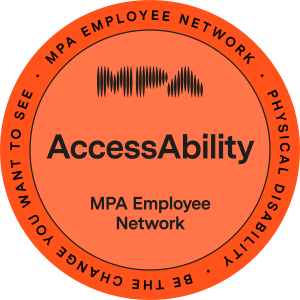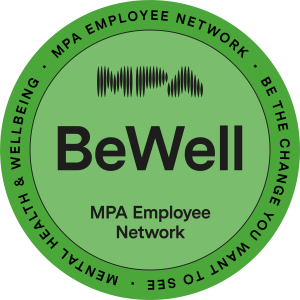The MPA celebrates Deaf Awareness Week – Beyond Silence
Date


Deaf Awareness Week takes place from May 5th to May 11th. Founded in 1993 by the UK Council on Deafness, the week aims to raise awareness about the isolation that Deaf individuals can experience and to champion inclusion by celebrating the richness and resilience of Deaf culture.
This year’s theme, “Beyond Silence,” invites us to look past outdated stereotypes and recognise the diverse identities, experiences, and contributions of Deaf people in society. “Beyond Silence” also encourages a deeper understanding of how Deaf and hard-of-hearing individuals communicate through British Sign Language (BSL), lip-reading, written language, and assistive technologies. At the same time, it highlights the social, cultural, and professional barriers many still face, urging us to break down these walls and build a more accessible world.
This year’s campaign is a call to action for individuals, organisations, and communities alike to move beyond passive awareness and actively create meaningful change. By learning BSL, improving workplace accessibility, ensuring equal access to education, and fostering inclusive public spaces, we can help shape a society where Deaf people are truly understood, valued, and empowered.
Understanding the deaf community
The Deaf community is a diverse group of individuals who identify as Deaf or hard of hearing. Communication preferences vary widely, what works well for one person may not be suitable for another.
Many Deaf people use British Sign Language (BSL) as their primary language, while others may prefer spoken language or a combination of both. Some use hearing aids or cochlear implants, while others choose not to. Each individual has their own preferred way of communicating.
The Deaf community is also a vibrant and active society. Those who use sign language often come together to share news, experiences, and take part in social, cultural, and other types of events. These shared activities foster a strong sense of belonging, and many Deaf individuals feel most comfortable in the company of others who share similar experiences.
While there are shared aspects of Deaf identity, the community includes a wide range of people. Some view themselves as part of a distinct cultural and linguistic group centred around sign language, while others do not. The community is made up of individuals with varied communication methods, cultural and ethnic backgrounds, and additional disabilities that shape their day-to-day interactions.
Hearing individuals who are interested in learning about sign language and Deaf culture are often welcomed and encouraged to engage with the community.
How you can get involved and support the deaf community
There are many ways we can support the deaf community and help to build a more inclusive society. Here are some ways you can participate in Deaf Awareness week and help support beyond this week:
- Learn BSL – Acquiring basic skills in British Sign Language (BSL) can enhance communication with Deaf individuals.
- Attend Deaf Awareness Events – Engage in local events such as workshops, exhibitions, or sign language concerts that promote Deaf culture and awareness.
- Promote Deaf friendly communication – Implement simple practices to improve interactions with Deaf individuals.
- Support Deaf Organisations – Contribute to organisations dedicated to the Deaf community through donations or volunteering.
- Utilis and Share Deaf Awareness Resources – Access free resources such as posters, flyers, and educational materials to distribute in schools, workplaces, or community centres, raising awareness about Deaf culture and communication.
- Advocate for Workplace Inclusivity – Encourage your employer to provide Deaf awareness training and ensure accessibility through tools like hearing loop systems or captioning services. Such initiatives create a more inclusive environment for Deaf colleagues.
- Wear Dark Blue – This is the colour to help promote deaf awareness and represent Deafhood.
Communication Do’s and Don’t’s
Do:
Get their attention – Get their attention before you try to communicate. There are several ways of doing this – the most used method for getting someone’s attention is to simply tap them lightly on the shoulder.
Lighting – Consider the type of the lighting and where it is coming from. If deaf people can’t see your face they can’t take cues such as reading your lips and facial expressions, so avoid situations where you are lit from behind.
Speak clearly and directly – This means speaking at your normal pace and volume. When communicating, make sure to use gestures and facial expressions, sometimes it is best to point things around you, use gesturing or write things down, or even use your phone. It is OK if you don’t know any sign language, do your best to act out what it is you need to say. Any visual cues you can provide can go a long way to improving communication.
Don’t:
- Don’t shout – This can make things harder for a deaf person if they are trying to read your lips, because when we shout our lip patterns become distorted.
- Don’t look away or cover your mouth – Deaf people are looking for cues such as body language and facial expressions, and if they can’t see you this makes communicating more difficult.
- Don’t change how you speak – Speaking too fast or too slow can distort the speech patterns and make lipreading more difficult. Try to just speak at your normal pace.
- Don’t give up – Communication with deaf people might be new to you, but remember, this is a challenge deaf people face daily.
- Don’t be dismissive – Try not to use phrases such as ‘Never mind’ or ‘it doesn’t matter’. This can cause further isolation and can be very disrespectful.
Celebrating Deaf Awareness Week
Deaf individuals are part of a rich and vibrant culture, with unique perspectives and powerful ways of communicating. Their contributions and experiences deeply enrich our communities. Deaf Awareness Week is a time to reflect, connect, and take action because true inclusion means more than breaking silence; it means amplifying voices, celebrating stories, and standing up for equal rights.
Resources
National Deaf Children’s Society
For more information or to join our AccessAbility Employee Network or BeWELL Employee Network, please contact:Helen Choudhury
Head of DEI, CSR and Wellbeing
[email protected]
Safiyah Olaide
DEI, CSR and Wellness Officer / OM
[email protected]
Share article